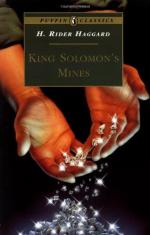There, upon huge pedestals of dark rock, sculptured with rude emblems of the Phallic worship, separated from each other by a distance of forty paces, and looking down the road which crossed some sixty miles of plain to Loo, were three colossal seated forms—two male and one female—each measuring about thirty feet from the crown of its head to the pedestal.
The female form, which was nude, was of great though severe beauty, but unfortunately the features had been injured by centuries of exposure to the weather. Rising from either side of her head were the points of a crescent. The two male Colossi, on the contrary, were draped, and presented a terrifying cast of features, especially the one to our right, which had the face of a devil. That to our left was serene in countenance, but the calm upon it seemed dreadful. It was the calm of that inhuman cruelty, Sir Henry remarked, which the ancients attributed to beings potent for good, who could yet watch the sufferings of humanity, if not without rejoicing, at least without sorrow. These three statues form a most awe-inspiring trinity, as they sit there in their solitude, and gaze out across the plain for ever.
Contemplating these “Silent Ones,” as the Kukuanas call them, an intense curiosity again seized us to know whose were the hands which had shaped them, who it was that had dug the pit and made the road. Whilst I was gazing and wondering, suddenly it occurred to me—being familiar with the Old Testament—that Solomon went astray after strange gods, the names of three of whom I remembered—“Ashtoreth, the goddess of the Zidonians, Chemosh, the god of the Moabites, and Milcom, the god of the children of Ammon”—and I suggested to my companions that the figures before us might represent these false and exploded divinities.
“Hum,” said Sir Henry, who is a scholar, having taken a high degree in classics at college, “there may be something in that; Ashtoreth of the Hebrews was the Astarte of the Phoenicians, who were the great traders of Solomon’s time. Astarte, who afterwards became the Aphrodite of the Greeks, was represented with horns like the half-moon, and there on the brow of the female figure are distinct horns. Perhaps these Colossi were designed by some Phoenician official who managed the mines. Who can say?"[*]
[*] Compare Milton, “Paradise Lost,” Book i.:—
“With
these in troop
Came Ashtoreth, whom the Phoenicians
called
Astarte, Queen of Heaven,
with crescent horns;
To whose bright image nightly
by the moon
Sidonian virgins paid their
vows and songs.”




